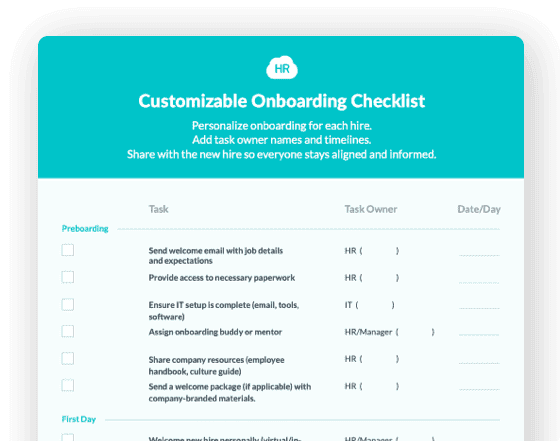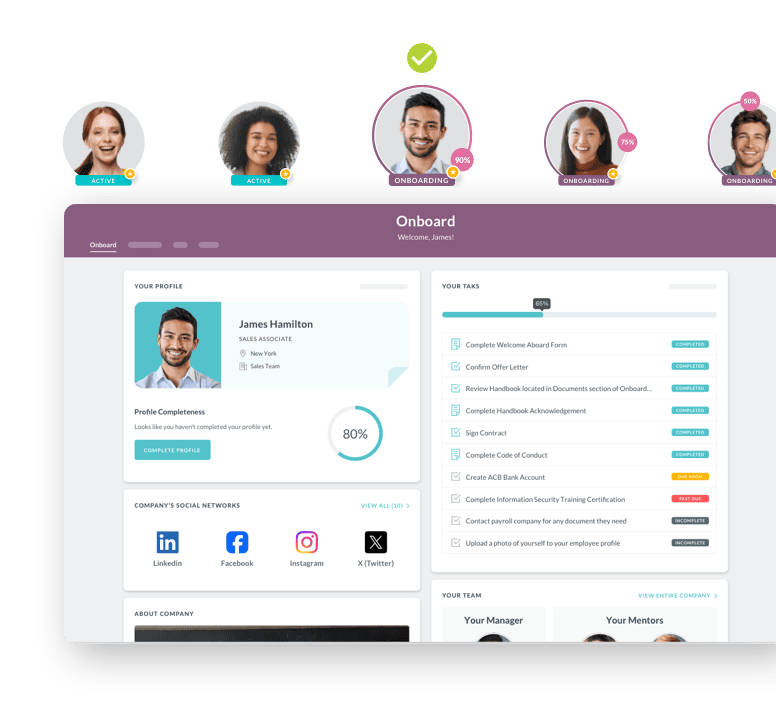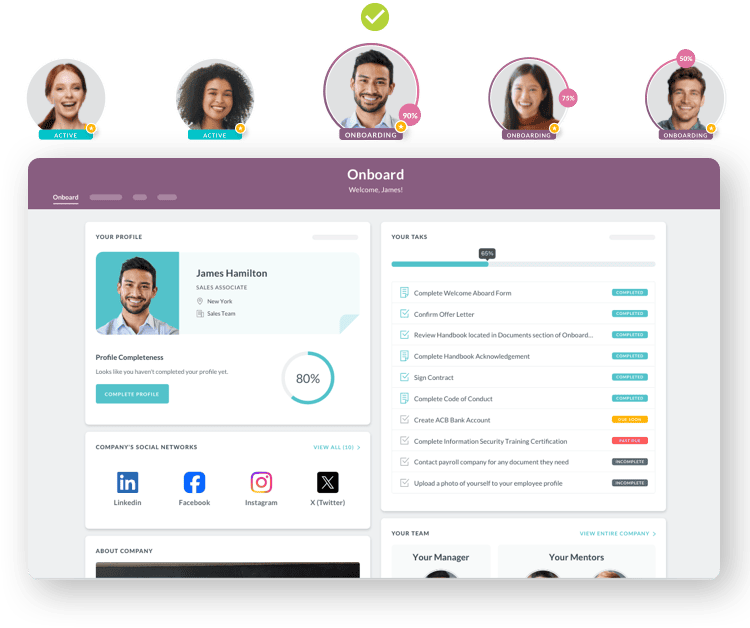Worker Behavior
- Understanding the Foundations of Worker Behavior
- Key Elements That Define Worker Behavior
- Behavioral Patterns That Drive Performance
- Best Practices for Encouraging Positive Worker Behavior
- Common Pitfalls That Undermine Worker Behavior
- Worker Behavior Applications Across Industries
- Building Your Worker Behavior Implementation Strategy
- The Future of Worker Behavior Management

 Cut onboarding time
by 60%—here's the
Ultimate Checklist
that helped do it.
Cut onboarding time
by 60%—here's the
Ultimate Checklist
that helped do it.

Worker behavior shapes every aspect of organizational success, from daily productivity to long-term growth. Understanding how employees act, respond, and engage in the workplace helps business leaders create environments where both people and performance thrive. This isn't just about following rules or meeting standards. It's about recognizing that employee actions, attitudes, and interactions drive measurable business outcomes.
The way people behave at work directly impacts your bottom line. Research from Gallup shows that highly engaged teams demonstrate 81% lower absenteeism and 43% lower turnover compared to less engaged teams. When you understand what motivates positive worker behavior, you gain the power to transform your organization from the inside out.
Worker behavior encompasses all the actions, attitudes, and interactions employees demonstrate within the workplace. This includes communication patterns, collaboration styles, ethical decision making, response to feedback, initiative taking, and alignment with organizational values. It covers both observable actions like punctuality and teamwork, as well as cognitive elements like problem solving approaches and decision making processes. At its core, worker behavior reflects how employees show up each day and contribute to organizational goals.
Understanding the Foundations of Worker Behavior
Worker behavior exists at the intersection of individual personality, organizational culture, and management practices. Harvard Business Review research reveals that positive work environments boost employee productivity by 31% and triple creative output. This connection between environment and behavior underscores why smart organizations focus on creating conditions that encourage positive actions rather than simply reacting to negative ones.
Several factors shape how employees behave at work. Personal values and work ethic form the foundation, but organizational culture, leadership quality, peer relationships, performance management systems, and recognition practices all play crucial roles. The most effective leaders recognize that worker behavior isn't static. It responds dynamically to the systems, incentives, and culture you create.
Key Elements That Define Worker Behavior
Before diving deeper, here are the fundamental aspects that characterize worker behavior in modern organizations:
-
Engagement level determines how emotionally connected and committed employees feel toward their work and organization, directly influencing their discretionary effort and performance quality.
-
Communication patterns reflect how employees share information, provide feedback, collaborate with colleagues, and interact with leadership across different channels and situations.
-
Initiative and proactivity show whether workers wait for direction or actively seek opportunities to solve problems, improve processes, and contribute beyond their basic job requirements.
-
Adaptability and resilience measure how employees respond to change, handle setbacks, learn from mistakes, and maintain productivity during periods of uncertainty or transition.
-
Ethical conduct and integrity encompass how workers make decisions, handle confidential information, treat colleagues, and align their actions with organizational values and professional standards.
-
Collaboration and teamwork indicate employees' willingness to support colleagues, share knowledge, participate in group efforts, and prioritize collective success over individual recognition.
Behavioral Patterns That Drive Performance
Understanding different worker behavior categories helps leaders identify what's working and what needs attention. The table below outlines key behavioral dimensions and their organizational impact:
|
Behavioral Dimension |
Positive Indicators |
Negative Indicators |
Business Impact |
|
Engagement |
Enthusiasm, ownership mindset, discretionary effort |
Minimal effort, clock watching, disconnection |
Direct correlation with productivity, innovation, and retention |
|
Communication |
Transparency, active listening, constructive feedback |
Information hoarding, avoiding difficult conversations |
Affects team cohesion, decision quality, and problem resolution speed |
|
Initiative |
Problem solving, process improvement, innovation |
Waiting for direction, avoiding responsibility |
Drives competitive advantage and organizational agility |
|
Adaptability |
Embracing change, learning orientation, resilience |
Resistance, rigidity, defensiveness |
Determines success during transitions and market shifts |
|
Collaboration |
Knowledge sharing, supporting colleagues, team focus |
Silos, competition over cooperation |
Impacts project success rates and organizational culture |
Best Practices for Encouraging Positive Worker Behavior
Creating an environment that naturally encourages productive behaviors requires intentional strategy and consistent execution. Start by recognizing that behavior change happens when you address root causes, not just symptoms.
Set crystal clear expectations from day one. Employees can't demonstrate desired behaviors if they don't know what success looks like. Use your employee onboarding process to establish behavioral standards early, connecting individual actions to organizational values and business outcomes. This foundation prevents confusion and creates accountability.
Lead by example at every level. SHRM research confirms that management honesty and addressing bad behavior within teams are critical elements of positive workplace culture. When leaders demonstrate the behaviors they expect, they create a powerful model that spreads throughout the organization.
Implement continuous feedback systems rather than relying solely on annual reviews. Research shows that 94% of employees prefer real-time feedback to formal reviews, and organizations with continuous feedback see 14.9% lower turnover rates. Regular check-ins through performance management tools allow you to reinforce positive behaviors immediately and address concerns before they become problems.
Create meaningful recognition programs that celebrate the right behaviors. Employee recognition platforms make it easy to acknowledge achievements in real time, reinforcing actions that align with organizational values. Recognition works best when it's specific, timely, and connected to clear performance standards.
Invest in manager development because 70% of variance in team engagement is determined by the manager alone. Train leaders to identify individual strengths, provide coaching, and create psychologically safe environments where employees feel comfortable taking initiative and speaking up. Strong managers multiply positive behaviors across their teams.
Align behavioral expectations with career growth opportunities. When employees see that positive behaviors lead to advancement, learning opportunities, and increased responsibility, they're more motivated to sustain those behaviors over time. Make the connection between how people work and where they can go explicit and transparent.


Common Pitfalls That Undermine Worker Behavior
Even well-intentioned organizations fall into traps that damage employee behavior. Understanding these pitfalls helps you avoid them and course correct quickly when they appear.
Inconsistent enforcement of standards creates cynicism and disengagement. When some employees face consequences for negative behaviors while others don't, you send a message that rules don't matter and favoritism rules. This inconsistency erodes trust faster than almost any other leadership mistake. Everyone must be held to the same behavioral standards regardless of their position or performance in other areas.
Focusing exclusively on outcomes while ignoring behaviors leads to toxic cultures. When you reward results at any cost, you implicitly encourage cutting corners, poor collaboration, and unethical conduct. Balance matters. Celebrate both what people achieve and how they achieve it, making clear that sustainable success requires both strong results and positive behaviors.
Neglecting the connection between worker behavior and employee engagement causes leaders to miss root causes of performance problems. Disengaged employees display negative behaviors not because they're bad workers but because their engagement needs aren't being met. Address the underlying engagement issues rather than just managing behavioral symptoms.
Relying on punishment rather than positive reinforcement creates fear based cultures where employees focus on avoiding mistakes rather than pursuing excellence. While consequences for serious misconduct are necessary, organizations that emphasize recognition and development see far better behavioral outcomes than those built primarily on disciplinary systems.
Ignoring early warning signs allows small behavioral issues to become major problems. When you notice declining engagement, increased absenteeism, or deteriorating communication patterns, investigate immediately. These signals often indicate systemic issues that require thoughtful intervention, not just individual performance conversations.
Worker Behavior Applications Across Industries
Different industries face unique behavioral challenges and opportunities, but the fundamental principles remain consistent. Successful organizations in every sector prioritize creating conditions that encourage positive worker behaviors aligned with their specific operational needs.
In healthcare settings, worker behavior literally impacts patient outcomes and safety. Healthcare organizations using HR Cloud focus heavily on communication protocols, attention to detail, empathy in patient interactions, and adherence to safety procedures. Positive behavioral patterns in healthcare reduce medical errors, improve patient satisfaction scores, and create environments where clinical staff can perform at their best under pressure. Leaders in this sector use behavioral assessments during hiring, ongoing behavioral training, and recognition programs that celebrate both clinical excellence and compassionate care delivery.
Manufacturing environments depend on safety conscious behaviors, quality focus, and process adherence. Worker behavior in these settings directly affects production efficiency, defect rates, and workplace injury statistics. Smart manufacturers create behavior based safety programs, implement peer observation systems where workers provide real time behavioral feedback, and use performance tracking tools to identify patterns that predict problems before they occur. Recognition programs in manufacturing often celebrate extended periods without safety incidents and process improvements suggested by frontline workers.
Technology companies face different behavioral imperatives centered on innovation, collaboration, and adaptability. Research indicates that while new technologies boost productivity, they can also affect worker motivation and engagement in complex ways. Tech organizations prioritize behaviors like knowledge sharing, constructive disagreement, rapid experimentation, and continuous learning. They create psychological safety where employees feel comfortable challenging assumptions, and they structure work to encourage cross functional collaboration rather than siloed individual contribution.
Building Your Worker Behavior Implementation Strategy
Transforming worker behavior across your organization requires a systematic approach. Follow these sequential steps to create lasting behavioral change that drives measurable results.
Start by conducting a comprehensive behavioral assessment. Survey employees, analyze performance data, review exit interview feedback, and gather manager observations to understand your current behavioral landscape. Identify which behaviors are serving your organization well and which need improvement. Use workplace performance review data to establish your baseline and set specific behavioral targets.
Define your desired behavioral culture clearly and specifically. Move beyond generic statements like "be a team player" to concrete descriptions of what positive behaviors look like in your unique context. Document behavioral expectations for different roles and situations, connecting them explicitly to your organizational values and strategic objectives. Make sure these expectations are realistic, measurable, and relevant to actual job performance.
Communicate your behavioral expectations throughout the organization. Use multiple channels and formats to ensure everyone understands what's expected and why it matters. Incorporate behavioral expectations into job descriptions, performance evaluations, team meetings, and leadership communications. The message should be consistent, frequent, and reinforced by visible leadership commitment.
Equip managers with tools and training to observe, assess, and coach behaviors effectively. Most managers need specific skills to provide behavioral feedback that changes actions without damaging relationships. Invest in training that covers difficult conversations, recognition techniques, and coaching methodologies. Provide managers with goal tracking software that helps them monitor behavioral progress alongside performance outcomes.
Implement systems that reinforce desired behaviors daily. This includes recognition programs, feedback mechanisms, performance metrics that include behavioral dimensions, and consequences for persistent negative behaviors. The key is consistency and fairness. Everyone should understand that positive behaviors lead to positive outcomes while negative behaviors have consequences, regardless of who engages in them.
Monitor behavioral trends over time and adjust your approach based on what you learn. Track metrics like engagement scores, turnover rates, safety incidents, collaboration patterns, and innovation metrics to gauge whether behavioral interventions are working. Be willing to experiment, measure results, and refine your strategy based on evidence rather than assumptions.
The Future of Worker Behavior Management
Worker behavior management is evolving rapidly as organizations embrace new technologies, adapt to changing workforce expectations, and recognize the strategic importance of behavioral dynamics. Forward thinking leaders are preparing for these shifts today.
Artificial intelligence and behavioral analytics are transforming how organizations understand and influence worker behavior. Companies now use sophisticated tools to analyze communication patterns, collaboration networks, and engagement signals in real time. These insights help leaders identify behavioral trends, predict turnover risk, and intervene proactively. However, the most effective approaches balance data driven insights with human judgment and empathy. Technology should enhance rather than replace authentic leadership.
Remote and hybrid work models are fundamentally changing behavioral expectations and management practices. Leaders must now focus on outcomes and asynchronous collaboration rather than physical presence and real time oversight. This shift requires greater emphasis on trust, clear communication, and behavioral accountability. Organizations that succeed in this environment create strong cultural foundations and behavioral norms that transcend physical location.
Generational diversity is creating new behavioral dynamics in the workplace. Younger workers often prioritize different values, communication styles, and work arrangements than their older colleagues. Smart organizations embrace this diversity, creating inclusive cultures that respect different behavioral preferences while maintaining cohesive standards around core values. Flexibility becomes key to managing behavior across generational lines.
The connection between worker behavior and employee well-being is gaining strategic importance. Organizations increasingly recognize that behavioral problems often stem from burnout, stress, or work life imbalance rather than character flaws. The future of behavior management includes greater focus on mental health support, sustainable work practices, and creating conditions where positive behaviors emerge naturally from engaged, healthy employees.
Prepare your organization for these trends by building flexible behavioral frameworks that can adapt as work evolves. Focus on timeless principles like respect, integrity, collaboration, and excellence while remaining open to how these values manifest in changing work environments. The organizations that thrive will be those that help employees understand not just what behaviors are expected, but why those behaviors matter for collective success.
 Discover how our HR solutions streamline onboarding, boost employee engagement, and simplify HR management
Discover how our HR solutions streamline onboarding, boost employee engagement, and simplify HR management
Keep Reading
From Manual to Automated: A Complete Guide to Digitizing Employee Onboarding for Large Organizations
Sarah Chen, Director of HR at a 7,000-employee healthcare organization, starts her Monday
Enterprise HR Software in 2025: Why Traditional Enterprise Platforms Fall Short and What Actually Works
Traditional enterprise human resources software systems promise comprehensive solutions
AI in Onboarding: Complete Guide for 2026
You’ve probably been hearing this multiple times a day — AI is transforming HR. But
Ready to streamline your onboarding process?
Book a demo today and see how HR Cloud can help you create an exceptional experience for your new employees.







